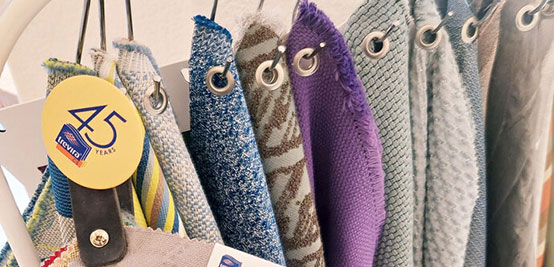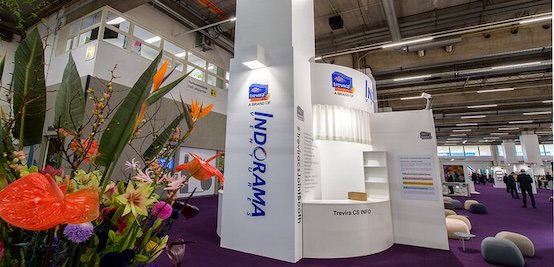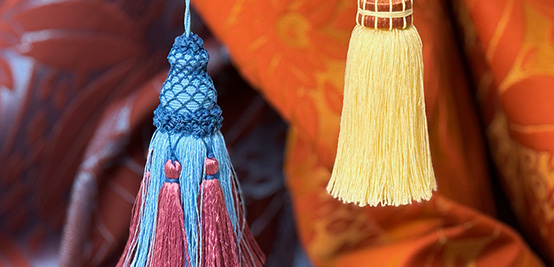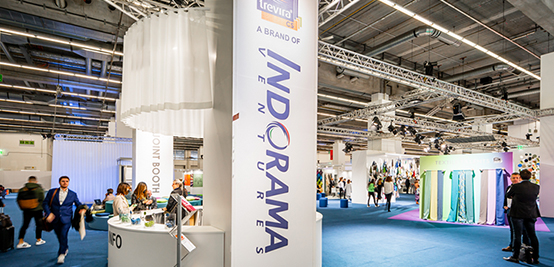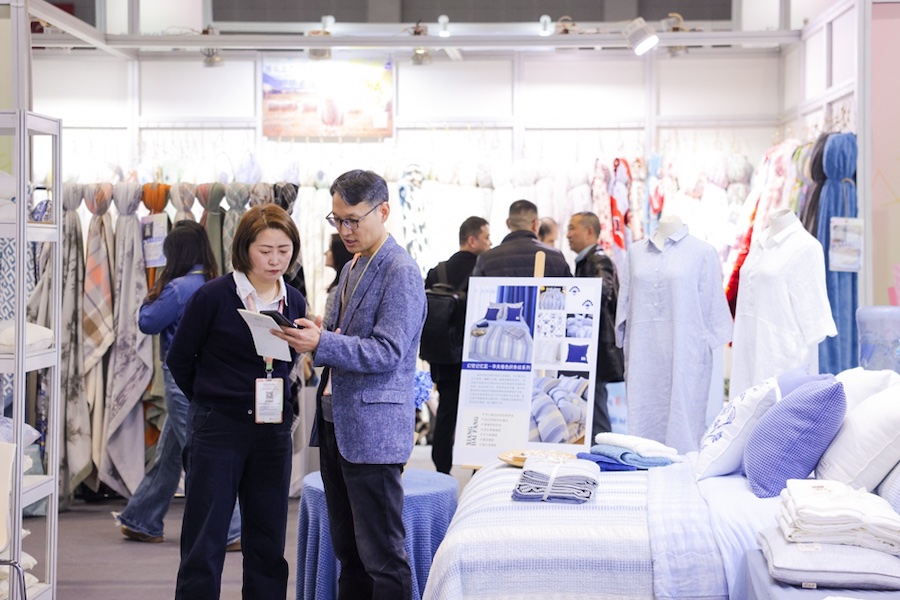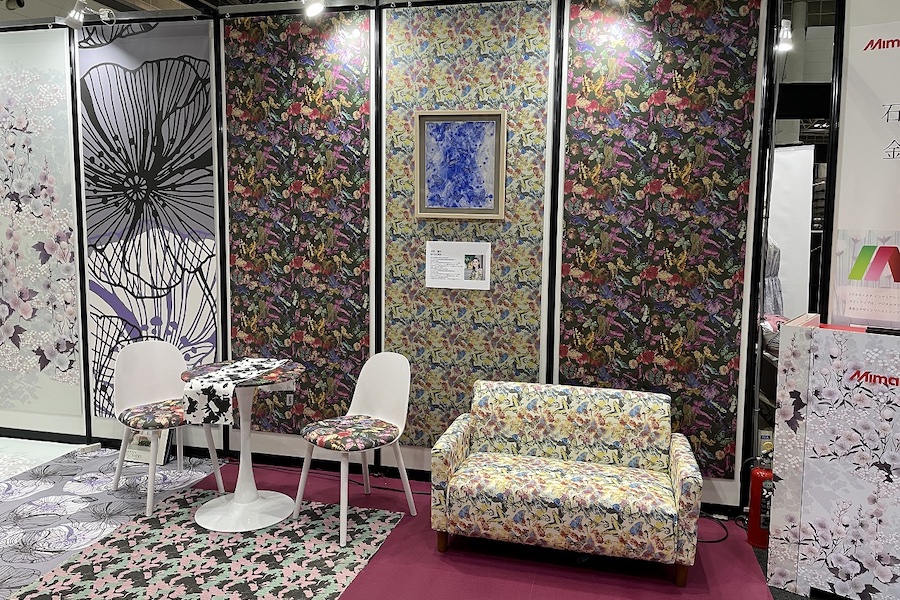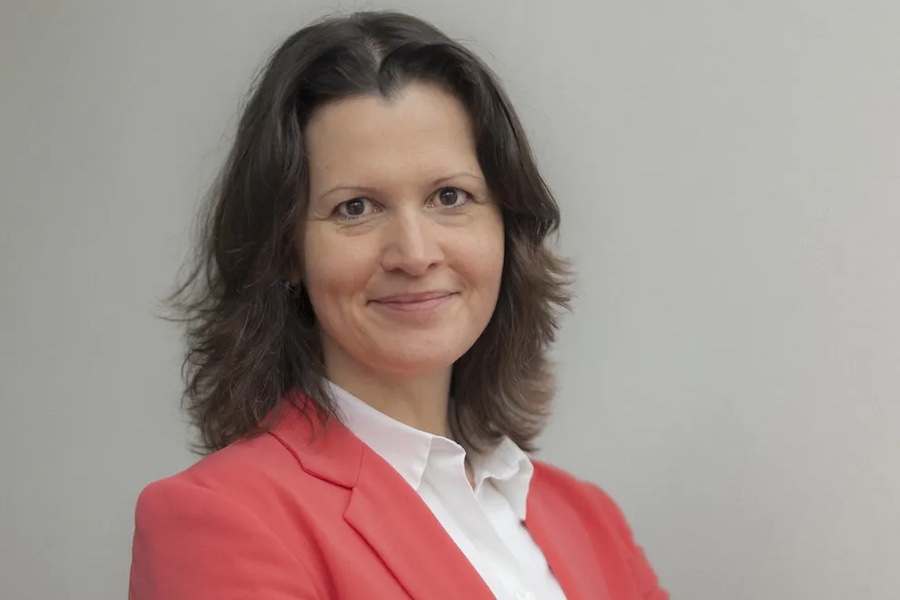#Home Textiles
Trevira with a look back at 2022 and an outlook on the latest solutions and developments to be presented at Heimtextil
Overall, 2022 was a challenging year for Trevira flame retardant fibres and filament yarns. Due to the massive increase in energy costs and resulting inflation, price adjustments were unavoidable. The generally prevailing, major market uncertainty also led to a reluctance to invest in the European contract market, which peaked in the fourth quarter. Overall, we are slightly optimistic about 2023 but expect the market to recover only in quarters 2-3.
In the area of flame retardant staple fibers, 2022 closed with volumes roughly at the level of the previous year. After the first nine months, we were still a good 10% above the previous year's volume, but this was put into perspective by a significant drop in demand in the fourth quarter. Unfortunately, we were not quite able to achieve our ambitious targets.
Particularly noteworthy is the high demand for recycled fibers (pre-consumer) for use in Trevira CS eco textiles. Unfortunately, due to delays in the ramp-up phase, we were not able to fully meet the requested quantities. We see significant growth potential here for 2023. The investment in a new melt filter for one of our spinning plants and the resulting process optimisation will help us to better meet the increasing demand. Our business in Italy and Turkey has proven to be particularly solid; here we achieved our set targets for 2022.
In the area of flame retardant filament yarns, we also fell slightly short of the targets set for 2022 and in terms of volume performed about 4% below plan. The Trevira CS business continues to focus on Europe, where we were able to maintain our sales volumes and our market shares in our most important markets – Italy, Germany and Scandinavia. In terms of market segments, we see strong demand in the office sector, where our yarns with high abrasion resistance are used.
For 2023 we have set a growth target of 5% for flame retardant filament yarns. This is to be generated by new product developments and the strengthening of our activities in the cruise sector as well as in the Turkish market.
Trevira CS at the 2023 Heimtextil Trade Fair:
Partnership, innovation, sustainability ... and loads of talent
Trevira CS Joint Booth with 18 Partners at 16 stands
The Trevira CS brand is presenting itself with 18 top customers at Heimtextil, which will be held in Frankfurt from January 10 to 13, 2023. The joint stand is located in Hall 4.0 / Stand C15 and covers an area of over 1,400 m².
Trevira CS customers and partners will be exhibiting their flame retardant products and new collections for the home textile and contract market at individual stands at the joint booth. Once again, all kinds of textile applications will be showcased by the exhibitors at this year’s Trevira CS booth. Their products include spun and textured yarns, curtains, decorative and upholstery fabrics as well as products for interior sun protection.
The following Trevira CS customers and partners will be exhibiting a wide variety of flame retardant yarns and Trevira CS fabrics at the joint booth: Chamatex SAS, F.lli Baroni s.r.l., FIDIVI Tessitura Vergnano S.p.A., Hoftex Färberei GmbH, Ilcat by Lei Tsu s.r.l., Lodetex S.p.A., Lonfil S.r.l., Mattes & Ammann GmbH & Co. KG, Mottura S.p.A., Pozzi Arturo S.p.A., PUGI R.G. S.R.L., Tessitura Mario Ghioldi & C. s.r.l., Tintoria Sala s.r.l., Torcitura Fibre Sintetiche S.p.A., Torcitura Padana S.p.A., Vlnap a.s., Wagenfelder Spinnereien GmbH and Wintex S.r.l.
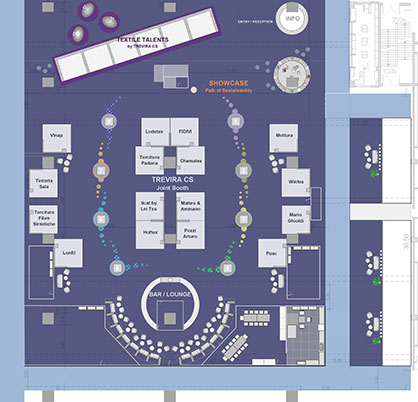
Sustainability Presentation “Path of Sustainability”
Highlight: Trevira CS prototype made from chemically recycled raw material
The Trevira CS brand presents its sustainable aspects along a sustainability path which extends 8 stations across the Trevira CS joint booth. Using questions and answers, we explore the complex issues revolving around what makes a product sustainable. The information chain deals with Trevira CS technology, particularly its sustainable product variants, the longevity of textiles, the Trevira CS eco brand for flame retardant fabrics with recycled content, and the take-back program for Trevira CS fabrics. At the end of the chain, a new product development prototype will be presented, giving insight into the brand’s future sustainable development opportunities.
The 8 Stations of the “Path of Sustainability“
What characterizes a business environment that promotes the development of sustainable products? Trevira CS is a brand of Indorama Ventures Public Company Limited (IVL), a global chemical company that has made sustainability an integral part of its corporate strategy. Indorama is headquartered in Thailand and has 26,000 employees in 35 countries on 6 continents at 147 production sites. As the world’s largest producer of PET, Indorama has responded to the challenge of resource management by establishing its recycling business. Recycled products include PET bottle flakes, recycled PET (rPET) and recycled fibers. Flame retardant filament yarns made from Indorama’s rPET are already used to produce Trevira CS eco textiles.
How sustainable is Trevira CS? On the market for over 40 years, Trevira CS has become synonymous with flame retardant textiles. Sustainable properties have been part of the product DNA from the very beginning. The innovative technology for flame retardant fibers and yarns eliminates the need for flame retardant finishes on textiles. The flame retardant additive is embedded in the molecular chain at an early stage of the manufacturing process, meaning no environmentally harmful substances can leak out – neither during use, during cleaning nor in the event of fire. A low-melt component in the fiber/yarn makes it possible to stiffen textiles without the use of a chemical finish. Flame retardant fibers as well as bright filament yarns are already available antimony-free; semi-dull antimony-free filament yarns are under development. Production in Europe guarantees compliance with strict safety and environmental standards. Trevira CS is a recyclable mono-material. All flame retardant Trevira products are STANDARD 100 certified by OEKO-TEX®. The flame retardant Trevira polymers have been assessed according to the GreenScreen® standard and are now listed in the GreenScreen® registry. GreenScreen® tests and evaluates chemicals for potential hazards to human health and the environment. The GreenScreen® standard is particularly significant for Trevira CS because the brand is widely trusted and specified in the healthcare sector. GreenScreen® certification forms the basis of the specification criteria for the Healthier Hospitals Initiative (HHI) in the US. Based on the achieved assessment of the flame retardant Trevira polymers, each textile manufacturer can individually certify their Trevira CS articles with GreenScreen®.
Can flame retardant Trevira products make textile solutions more sustainable? Trevira CS offers a new range of 30 flame retardant, UV-stable, spun-dyed yarns that are particularly suitable for outdoor use in the hospitality sector and the cruise ship industries due to their high light fastness and UV resistance. In addition, they score with sustainable properties, because the fabrics made from them can be produced in a more environmentally friendly way than textiles made from conventional yarns. The use of spun-dyed yarns is easier on the environment because there is no need to dye yarns and fabrics. The production of textiles from spun-dyed yarns requires fewer resources, including energy, water and chemicals. Even in outdoor conditions, fabrics are long-lasting and durable, meaning enduring colour quality, no fading, UV stabilizing for long-lasting strength.
The new colour palette was developed by Judith van Vliet, The Color Authority™. It refers to the trend colours used particularly in the outdoor applications of the contract market segments Hospitality and Cruise.
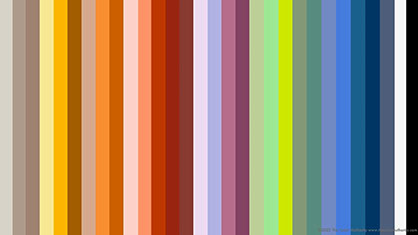
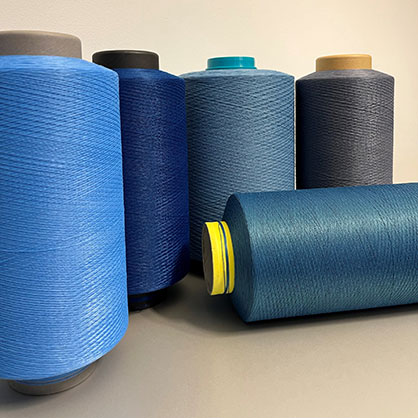
How durable are Trevira CS fabrics? Numerous Trevira CS collections are characterized by a timeless design and they have been on the market unchanged for many years. Combined with the long durability and hard-wearing nature of the material, Trevira CS fabrics can be enjoyed for a long time. The flame retardant function remains unchanged throughout the product’s entire functioning life cycle. Existing textile products can be complemented by new versions with additional colours or functions - the flame retardant performance of both older and new Trevira CS fabrics is absolutely comparable. Trevira CS fabrics are easy to clean. Easy maintenance increases the lifespan of a product. With a timeless design, Trevira CS fabrics can become classics.
Are there Trevira CS products with recycled content? Trevira CS fabrics are also available in recycled variants. They consist of fiber and filament yarns obtained in various recycling processes. Fabrics made from these yarns can obtain the Trevira CS eco trademark. The prerequisite for this is a recycled content of at least 50 %. Filament yarns are produced using recycled PET bottles, meaning yarns contain 50% post-consumer recycled material. Recycled fibers are made from 100% recycled material (pre-consumer recycling) obtained from production waste via an agglomeration plant and further processing steps. All flame retardant, recycled Trevira products are GRS (Global Recycled Standard) certified.
Is there a take-back option for Trevira CS fabrics and what is made out of them? There is a take-back and recycling option for Trevira CS fabrics. Used Trevira CS fabrics (post-consumer) or unsold Trevira CS residual materials (pre-consumer) can be recycled as part of the Trevira CS return program. Only Trevira CS qualified fabrics can be returned. The mechanical recycling process and further processing into nonwovens occurs at the ALTEX recycling company in Gronau, Germany. The fabrics are mechanically recycled and shredded into torn fibers, which are further processed into nonwovens with various specifications, if necessary, by adding new and/or low-melt fibers. These can be used in a variety of ways, like for thermal and acoustic insulation and as soundproofing panels. Nonwovens for acoustic panels are particularly interesting, becoming sound-absorbing wall coverings, free-standing partitions, ceiling suspensions or decorative objects, to name a few. In many cases, these items are covered with Trevira CS fabrics, creating an attractive product which also avoids waste and conserves resources. The Trevira CS return project is important for avoiding waste and conserving resources.
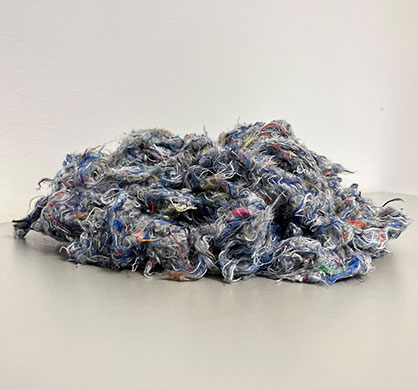
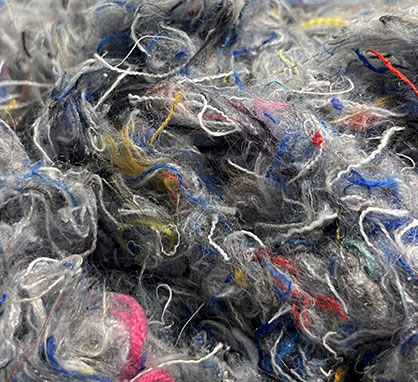
What does a network look like that promotes the sustainable development of the Trevira CS brand? Together on the path to more sustainability: with our direct and indirect customers and partners we share the common understanding of acting responsibly in the development, production and marketing of our products and using resources sparingly. Additionally, we have the same aspiration to continually make our Trevira CS products more sustainable. It pursues uniform product communication in accordance with brand rules along all stages of the textile value chain. This means that users of Trevira CS textiles can always be sure that the fabrics comply with the important international fire safety standards and, where applicable, also with the sustainability criteria of the Trevira CS eco brand.
What could Trevira CS's entry into the circular economy look like? The long-term goal in developing sustainable products is undoubtedly to enter a circular economy. What aspect of Trevira CS development is moving in this direction? Director Marketing Trevira CS, Anke Vollenbröker: “For some time now, we have been looking for ways to make Trevira CS more sustainable in this sense. This is not just about creating a new “status quo” but about embarking on a new path for moving forward into the future.”
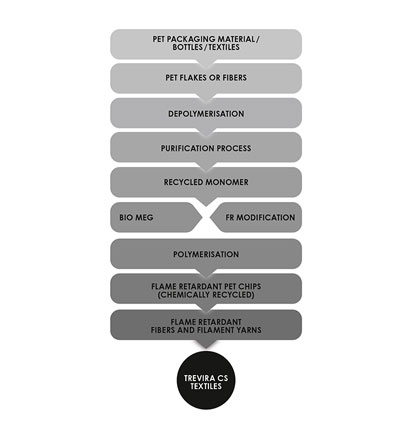
The starting point for the new development is a chemically recycled raw material. Thereby, in this innovative Trevira CS product development, fibers and filament yarns are made from raw material, which is chemically recycled for the most part and, to a smaller extent, from renewable raw material.
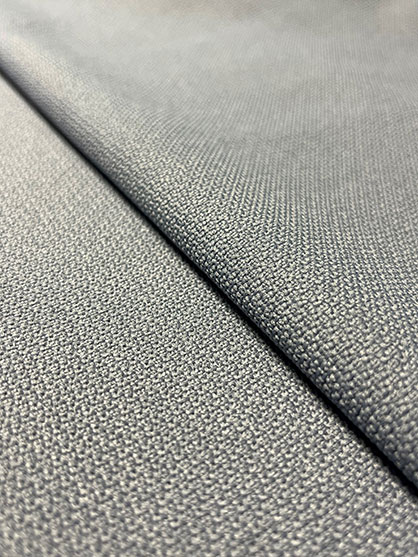
How exactly does that work? In this case, the basic raw material for the chemical recycling is PET bottles, but essentially it could be most any other PET waste, such as packaging material or textiles. Chemical recycling involves depolymerisation, a sequence of chemical reactions in which the polymer chains are broken down again into their original components, i. e. the monomers. In a further processing step, impurities are removed.
Before the polymerisation process, a proportion of bio-MEG (mono ethylene glycol) is added. Bio-MEG is produced from renewable plant-based raw materials instead of fossil raw materials. It should be noted that the term “bio” does not imply biodegradability but instead refers solely to the replacement of a petrochemical component.
How does the raw material become flame retardant? The same technology used to produce the original (virgin) raw material for Trevira CS is also used here. The flame retardant modification is added before polymerisation. In this way, the flame retardant properties are indelibly anchored in the polymer. We do not compromise on safety or environmental protection here either. A patent is pending for this new technology.
What are the advantages of this approach? On one hand, we are avoiding waste because packaging material is getting recycled. On the other hand, we are conserving resources by replacing petrochemical components with biological components which use renewable raw materials. Director Marketing Trevira CS, Anke Vollenbröker: ”The biggest advantage, however, lies in the potential that this approach has for the future. If we use raw materials obtained through the chemical recycling of PET packaging today, we could then potentially recycle textile waste in a similar fashion in the future. With these first steps, the path to a circular economy is underway.”
From the flame retardant filament yarns produced using the chemically recycled raw material, Gabriel A/S has produced a fabric that measures up to all specifications of the Trevira CS original. The flame retardancy performance, as well as the look and feel of the new product, are absolutely comparable to the original.
Special Exhibition – “TEXTILE TALENTS by Trevira CS”
This year, the Trevira CS joint booth will again host a special exhibition designed with the entries to the 2023 Trevira CS Fabric Creativity Competition. Fifty customers submitted 227 items in a wide array of colour combinations. For the special exhibition, 228 materials were selected, including several thousand metres of yarn.
The focus of this year's special show is on staging the special additional functions and properties that Trevira CS fabrics have in addition to their flame retardancy. Within the categories of variety, function and sustainability, the focus will be on the following themes:
VARIETY
- The New Visions: New, strongly designed, striking article
- The Kings of Colour: Trevira CS articles available in the widest possible colour range
- The Naturalists: Trevira CS fabrics with the talent to recreate looks like wool, cotton, linen and silk
FUNCTION
- The Sound Managers: Textiles with sound-absorbing functions
- The Irresistibles: Articles with excellent haptic properties
- The Masters of Light and Darkness: Materials responsible for light control, i.e. sun protection and darkening
- The Hardwearing: Fabrics with particularly high abrasion resistance values
- The Great Outdoors: Outdoor or indoor/outdoor fabrics
- The Superheroes: Fabrics with multiple functions
SUSTAINABILITY
- The Revivers: Trevira CS eco articles
- The Timeless Wonders: Trevira CS classics that can be used for many years due to their timeless design and durability
A jury viewed and evaluated the articles submitted to the Trevira CS Fabric Creativity Competition. Twenty-three materials received a special award. The jury consisted of Professor Bettina Göttke-Krogmann from Burg Giebichenstein University of Art and Design Halle, Claudia Herke from stilbüro bora.herke.palmisano in Frankfurt, and Angelika Vienken, interior designer, visual artist and lecturer from Düsseldorf.

Angelika Vienken was asked and fortunately accepted to design the special exhibition “TEXTILE TALENTS by Trevira CS” and created the stagings based on the specified themes. The presentation goes beyond the usual furnishing and decorating topics and playfully showcases what Trevira CS fabrics can do. Plus, with a bit of whimsy, there is plenty of inspiration for the creative use of textiles. In 6 rooms, the individual scenes address one or more of the themes. What is more, this year’s Trevira CS special show also has an interactive component. The individual scenes can be walked through and visitors can use them as photo boxes.
2023 Trevira CS Fabric Creativity Competition: Special awards
In the VARIETY category, the jury recognised the following submissions with a special award:
A beautiful, semi-dense 3D knit, with a cotton-like feel that perfectly blocks out direct sunlight yet still lets in enough light to brighten up the room. The 3D look gives the curtain depth, especially when used in multiple layers. The curtain has a presence, like an object or feature in the room, standing on its own.
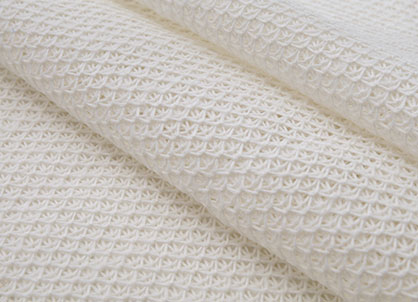
With its op art look, article 19955 (prototype) by Lodetex is a fabric that attracts attention. It is a voluminous, slightly elastic material. Here, effects from knitting served as inspiration, which were transferred to a woven jacquard. The result is a very interesting fabric that looks like knitted and at the same time brings a pleated effect due to its high-low structure. The fabric can be used as an upholstery fabric, as a panel curtain, and especially as a room divider in modern office environments, where its patterning is sure to impress from a distance.
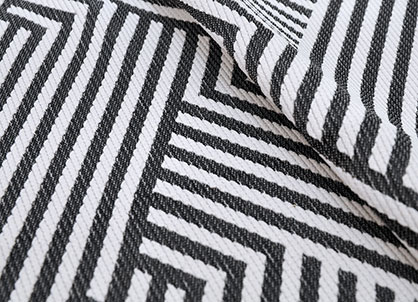
The article LAGUNA by Engelbert E. Stieger is a semi-transparent, linen look curtain fabric that exudes clarity, modernity and timelessness. The matt effect is reminiscent of elegant linen and provides a beautiful drape and a pleasant feel. The piece dyer is room-high and available in more than 80 colours. On the market for more than 20 years, it is also a candidate for the Timeless Wonders category. The curtain is versatile and suitable for both the contract and residential markets.
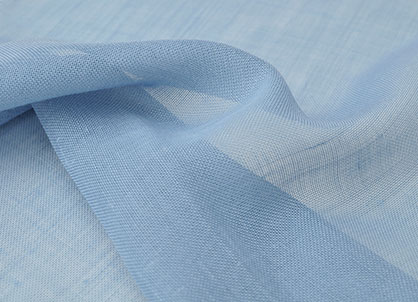
The article MONZA by Kobe is a heavy, valuable velvet with a dense pile. It is vibrant with its beautiful faux-cotton look, pleasant feel and expressive colours. This impression is enhanced by a shading effect created in the finishing process. The article is available in a wide range of colours – 30 in total.
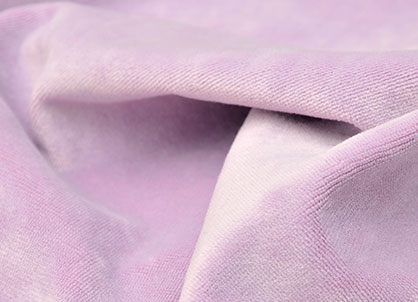
The prototype T2201 by Regina Baumann already exists in 40 colours and 20 more are planned. The upholstery fabric is versatile and elegantly timeless. The intense colours embody value. The look of stitched seams adds a sporty touch.

The look and feel of Regina Baumann’s article T2204 (prototype) are nearly indistinguishable from wool. With its raised surface, the article is reminiscent of wool felt or loden.
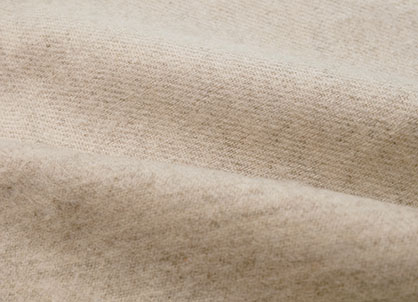
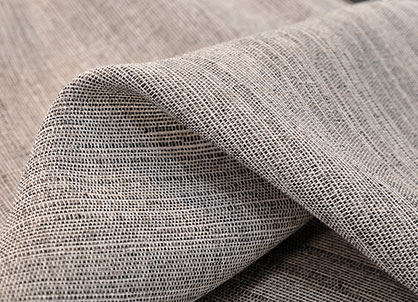
In many ways, the SHELTER article (prototype) by Tapicerías Gancedo S.A. is reminiscent of linen: the “dry” feel and stiffness of the material, the yarn irregularities and the matt sheen usually describe linen. Here we have a flame retardant polyester fabric with the look and feel of an expressive linen quality.
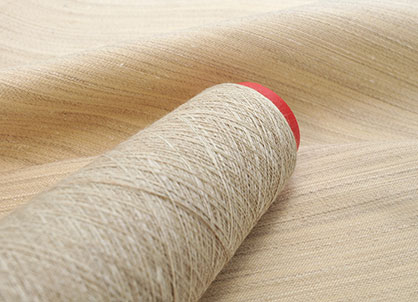
The yarn SHANTUNG (prototype) by Tintoria Sala s.r.l. is a two-toned slub yarn in silk look. It makes for wonderful curtain fabrics with an appearance of wild silk.
In the FUNCTION category, the jury recognised the following submissions with a special award:
The article CS GRAHAM by Gebrüder Munzert GmbH & Co. KG is a semi-transparent decorative fabric with a reserved pattern and colouring. It also has sound-absorbing properties, giving it a notch up.
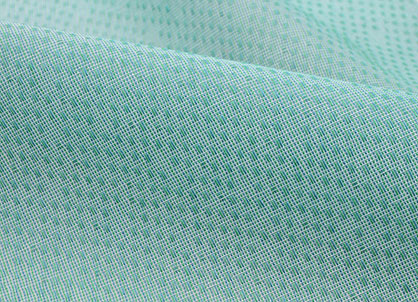
MIRAGE 3D is a knitted, bi-elastic fabric with a three-dimensional structure. It is soft and adapts perfectly to any shape of furniture or object. The piqué look of the fabric design adds a sporty touch. The fabric is sound-absorbing and particularly suitable for use in office spaces. It would also perform well as a cover fabric for soundproofing panels and ceiling absorbers.
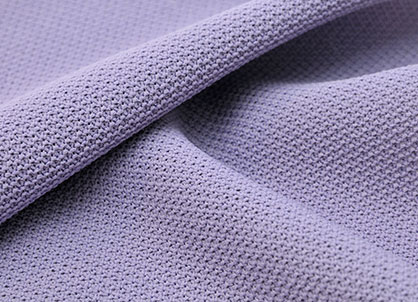
Soft and woolly – the article GRÈS by Engelbert E. Stieger is soothing to the touch. A special yarn and dyeing process give this piece dyer its natural look and beautiful mottling effect.
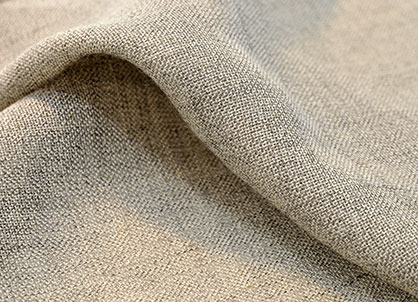
The name says it all: PERCALE typically describes a densely woven, medium-weight, fine-threaded cotton fabric made in plain weave. Stotz has given this Trevira CS article the same name for its cotton-like effects – a light article, soft yet firm, with bounce and a beautiful drape.
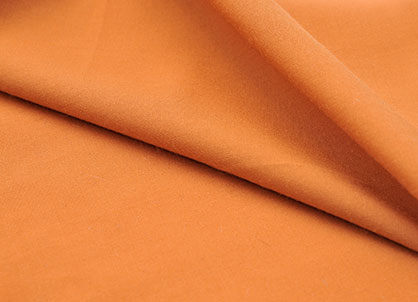
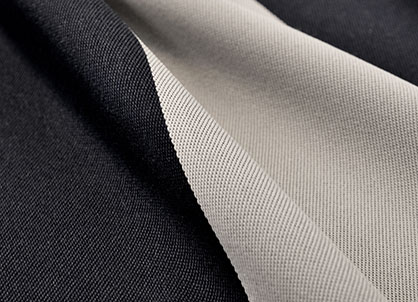
The article 18329 (prototype) from Lodetex S.p.A. is a new, innovative product development. This densely woven curtain can black out light by 100%. In addition to its black-out qualities, the article is soft, has a beautiful, heavy drape and a modern striped design.
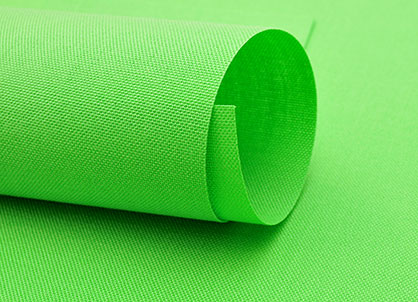
The article VEROSAFE 12.121 from Verotex AG, made for vertical or roller blinds in interior sun protection, surprises with its modern colourfulness and a large palette of exciting hues.
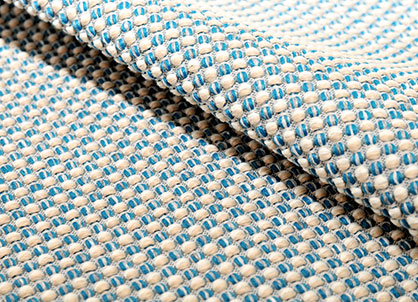
The elaborately woven article MAX from Delius GmbH & Co. KG is an upholstery fabric with a raised pattern and a grainy structure in 3D look. With its naturally matt surface and colourful woven design one would scarcely guess that it can withstand 100,000 abrasion cycles. It can prove this especially in hotels and restaurants or in cultural venues like cinemas and theatres.
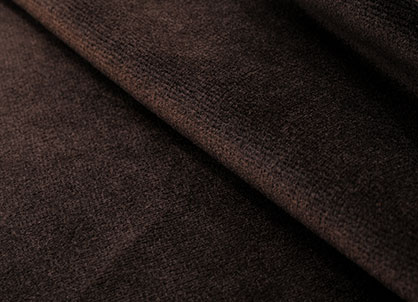
Soft yet durable. The article CELINE CS by Spandauer Velours GmbH & Co. KG is a compact, sturdy velvet with a mohair look. With 170,000 abrasion cycles, it is predestined for areas of application with high demands, e. g. cinemas, theatres or congress centres.
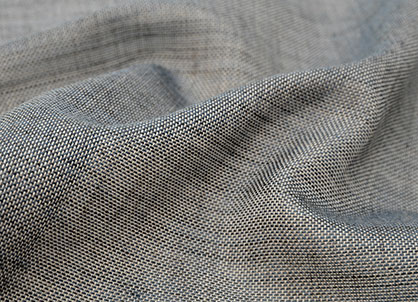
The article OUTDOOR DENVER 330 by Création Baumann is a semi-transparent curtain fabric for indoor and outdoor use. The yarn dyer made of Trevira CS is reminiscent of linen in terms of structure. However, the mottled yarn has an even surface and creates a homogeneous appearance.
The article is available in 12 natural shades and has very good light, colour and UV resistance. Using a curtain fabric outdoors is also an interesting concept here, for textiles can create spaces and make for a homey atmosphere.
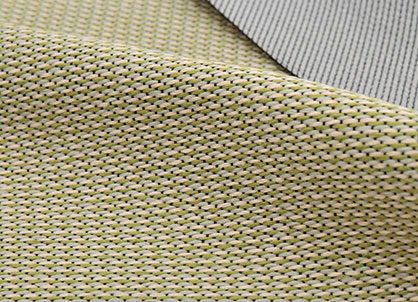
The article SONIC MELT from Création Baumann is a master of multifunction. The top sound absorber has a dense, multilayer fabric structure. Three different coloured yarns form a braided look on the front side and, depending on the distance, act as a faux-uni or as a lively structure. The calm, plain-colored reverse, on the other hand, shows itself in a fine twill weave. Attractive from both sides, the article is particularly suitable as a room divider, where it can perfectly unfold its acoustic effect.
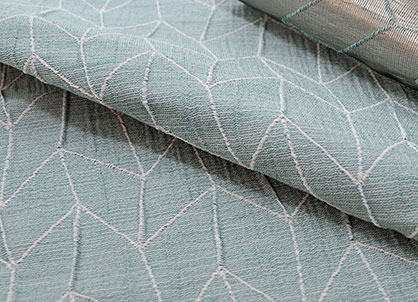
The use of heat-shrunk yarn in the weft lends a modern, 3D effect to the fine-lined, geometric zigzag design. The heat-shrunk yarn also gives the back of the fabric a bright look, ensuring that ZAG achieves good transmission values and, in so doing, provides protection from the sun, glare and UV rays, which makes it energy-efficient.
In the SUSTAINABILITY category, the jury recognised the following submissions with a special award:
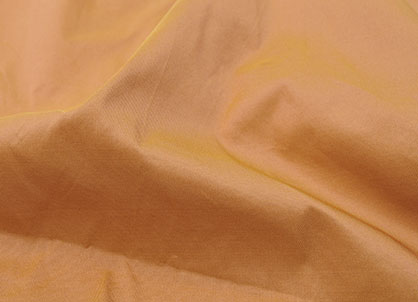
The Trevira CS eco article MURANO by C&C Milano is a taffeta made from 50% post-consumer recycled material. Available in 24, partly iridescent colours, Murano is proof that fabrics made from recycled materials are as valuable and attractive as their originals. The Murano article also exudes typical taffeta characteristics, such as its firmness and the noble shine.
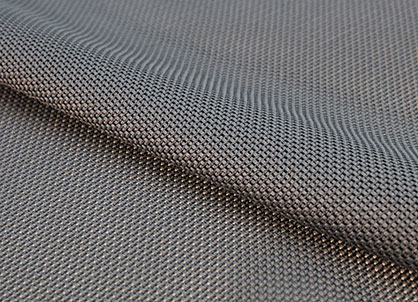
The Trevira CS eco article ENERGY (prototype) by FIDIVI lives up to its name. A mesh fabric with a sporty look, it is reminiscent of the mesh fabrics used in athletic shoes. It is designed as an upholstery fabric or as textile backrests. This technical look was implemented using recycled flame retardant filament yarns.

The fiber yarn ECO ZEUS by Tintoria Sala consists of yarns made of 100% recycled material (pre-consumer). Compact and with its two-tone look, it is very modern and contemporary. It is used for fabrics that can get the brand Trevira CS eco.
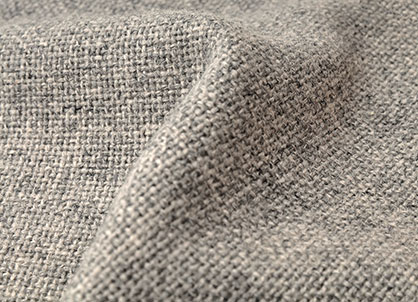
The article TREVI by Pugi with its timeless look has been on the market for more than 40 years. With its rough woven pattern, it was in fashion then as it is now – a true design classic.



